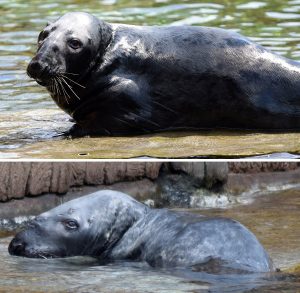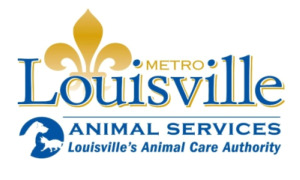 Boone and Minnow, two male gray seals, have joined the other pinnipeds on regular rotation at the Louisville Zoo’s Glacier Run exhibit. Both seals come to Louisville from Chicago’s Brookfield Zoo.
Boone and Minnow, two male gray seals, have joined the other pinnipeds on regular rotation at the Louisville Zoo’s Glacier Run exhibit. Both seals come to Louisville from Chicago’s Brookfield Zoo.
Minnow (bottom right), who is 31 years old, and Boone (top right),13, join California sea lions Triton (28), Bart (25), Gremlin (14), Riva (4), along with harbor seal Toney (16) and gray seal Rona (4) in the popular habitat.
The Louisville Zoo has a rich history with this species of animal. Eight seal pups have been born at the Zoo and when twin seal pups were born in 1979, they were the first twins to be documented in a managed system such as a Zoo.
Gray seals are natively found in temperate and subarctic waters on both sides of the North Atlantic. Seals have good senses to help them hunt. Their eyesight is excellent because of the time they spend underwater. Baby seals, called pups, are born with a soft, white hair coat called the lanugo. By the time they are weaned the lanugo is molted and the pups assume the adult coloration. Seal pups don’t swim until they have molted. Seal pups are weaned after nursing only four weeks during which they gain 100 pounds. Gray seals can sleep underwater for up to 30 minutes at a time. This species can be distinguished from harbor seals by their longer noses, wider set nostrils and size, which is approximately twice as large as harbor seals. They primarily eat fish.
The Louisville Zoo, a nonprofit organization and state zoo of Kentucky, is dedicated to bettering the bond between people and our planet by providing excellent care for animals, a great experience for visitors, and leadership in scientific research and conservation education. The Zoo is accredited by the American Alliance of Museums (AAM) and by the Association of Zoos and Aquariums (AZA).
You can visit the Louisville zoo at 1100 Trevilian Way. Gates are open 10am through 5pm until September 23. From September 23 through March 15, gates are open 10am to 4pm.
Carolyn E. Congleton, DVM
Louisville Metro Animal Services
 Each summer Louisville Veterinarians treat numerous cases of heat-stroke and heat-exhaustion in pets. Unfortunately some of these cases end in pet death; sadly nearly 100 % of these cases are preventable. Most heat related deaths are in dogs and horses but sometimes cats can be victims of heat-related illness as well. In dogs the scenario is usually related to “forced exercise” or being left unattended in a car. Very rarely is a free-roaming dog victim of heat-stoke. A dog being chained outside without proper water and shade is also at risk of illness or death.
Each summer Louisville Veterinarians treat numerous cases of heat-stroke and heat-exhaustion in pets. Unfortunately some of these cases end in pet death; sadly nearly 100 % of these cases are preventable. Most heat related deaths are in dogs and horses but sometimes cats can be victims of heat-related illness as well. In dogs the scenario is usually related to “forced exercise” or being left unattended in a car. Very rarely is a free-roaming dog victim of heat-stoke. A dog being chained outside without proper water and shade is also at risk of illness or death.
Dogs should always have access to fresh water and shade or shelter at all times. A dog house with ice water inside is preferable. A large tree in the back yard is excellent shade for people and pets. Because dogs cannot sweat like people they have a hard time regulating their body temperature during exercise. If they are pulled by a leash they can’t voluntarily stop (like we humans can), they just have to keep going even though they are exhausted! If you jog with your pet do so in the early morning before extreme heat. Always watch your pooch for signs of exhaustion such as excessive panting or salivating.
The normal body temperature for a dog in the summer is 101-102 F, temperatures above 105 are in the danger zone and your pet is in trouble. If you have a hunting dog do not hunt in the heat of the day, hunting is also considered forced exercise. Never leave your dog or cat in a parked car. The temperature can skyrocket in a matter of minutes and your pooch could parish!
If you have a horse that is exercised be sure to have water available and remember there should be a “cooling-down period”. Horses transported in trailers need good ventilation and fresh water. Do not leave your horse unattended in a trailer.
For more information contact your local Veterinarian or the American Veterinary Medical Association at www.avma.org
 Weather
Weather Traffic
Traffic @LouisvilleDispatch
@LouisvilleDispatch @LouisvilleDisp
@LouisvilleDisp Subscribe
Subscribe